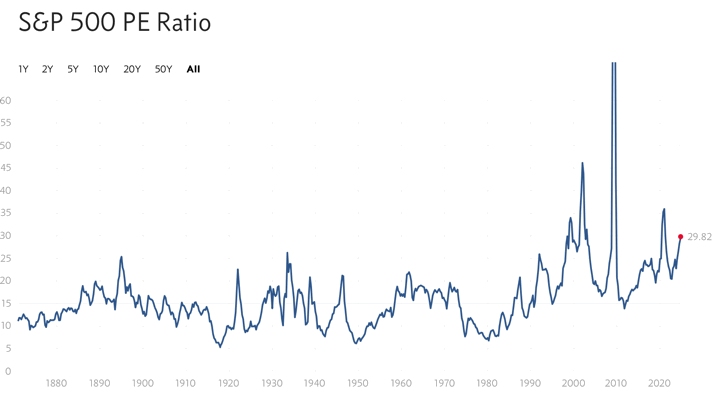The S&P 500 has been on a great run recently, up around 30% over the last 12 months! Most of us are probably pretty satisfied with our brokerage accounts right now. (I know I am.) But where is it coming from? The total return of the S&P 500 can be broken down into three components:
Total Return = Earnings Growth + Dividend Yield ± P/E Multiple Changes
In other words, business profits could go up (or down), the dividends that get mailed out could go up or down, and how much investors are willing to pay for each bit of profit could change. This last one, the P/E “Multiple” is rather fickle, and P/E ratios can go up and down, but rarely stays highly elevated for extended periods of time.
Above is the historical S&P 500 P/E ratio chart from Multpl. The last time I wrote a post like this was when the screenshot said the P/E ratio rounded off to 35. Today it is 30. So the P/E ratio has been even higher in the recent past… but it also didn’t stay that high for very long.
Here is a very handy chart that breaks down the S&P 500 return over the last few years. Credit to @Sonusvarghese via Abnormal Returns.

The chart itself says “profit growth has been driving returns” and definitely that is true over the longer run, but it is also important to appreciate how much P/E ratio changes can affect future returns, even if profit growth continues. This is because the effect of P/E ratio doesn’t just go to zero when our collective optimism cools a bit – it has the same power in reverse.
Take all of 2024 year-to-date. Yes, profit growth added 11%, but multiple growth added 10%. The P/E ratio went from ~25 to ~30. If for the next 9 months, profits kept growing at the same positive pace, but the P/E ratio simply went back to where it was at the beginning of 2024, then your total return would be only 1% over that time period. The +10% boost comes back as a -10% haircut.
If for the next 9 months, profits kept steady, but the P/E ratio simply went back to where it was at the beginning of 2024, then your total return would be negative 10% over that time period.
Or the P/E ratio could zoom off to 35 again. Who knows. I’m not talking about market timing, and I remain a buy-and-hold investor that avoids daily market noise, but I do poke my head up once in a while. Mostly, I use these check-ins to stay calm when things get a little fizzy or a little panicky.
See also: S&P 500 Returns by Components 1900-2020


